Just a few hours ago I was able to complete my first moonbounce / EME QSO on 70cm with DL7APV in JO62. Here is the whole story.
All started a while a ago with a simple Tweet (isn’t it always the case?) by SA5IKN [1]. Following his feed he was able to make a EME QSO on 70cm using his LEO sat equipment. This immediately caught my attention and I started to gather a few parts together to give it a try.
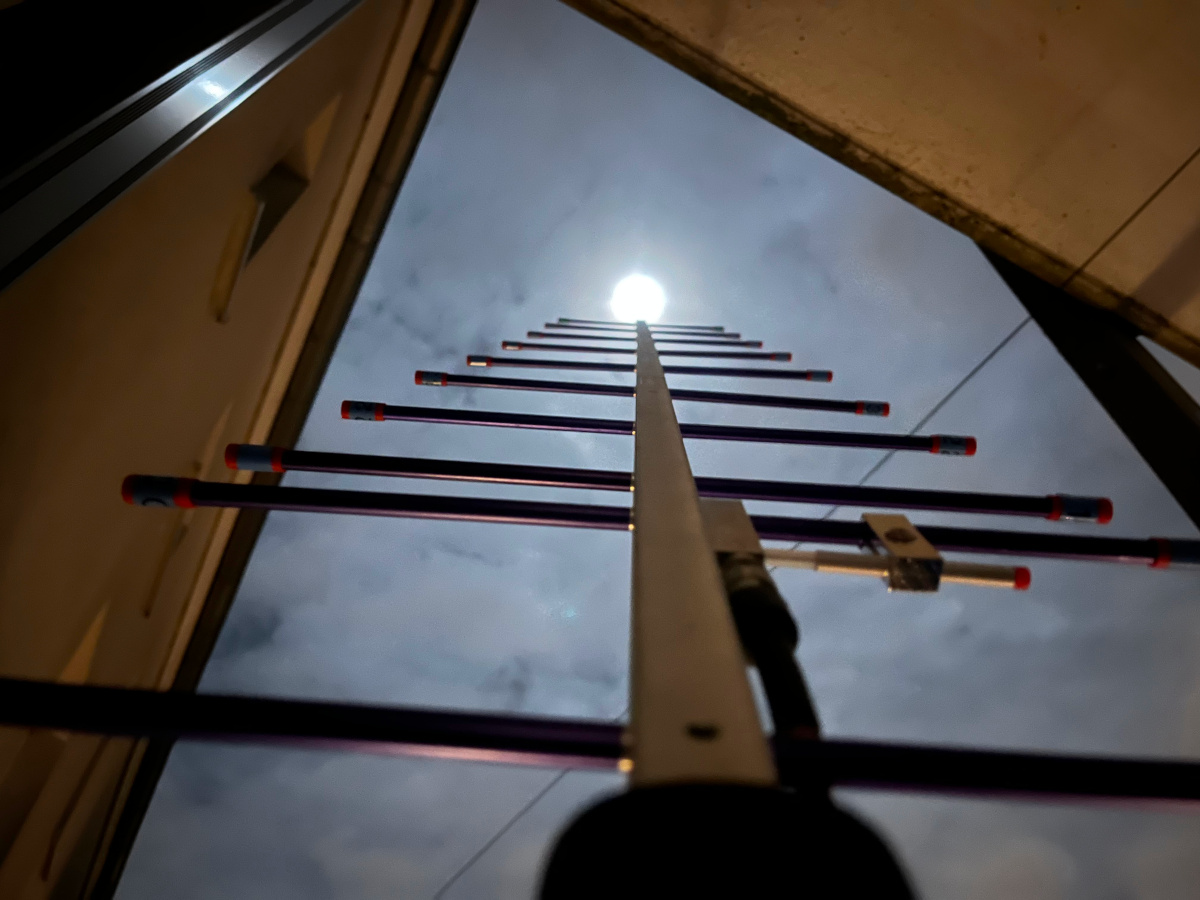
The first attempt was made from home through the open window and from the balcony at home. Sked was made using HB9Q logger (see [2]) and Bernd, DL7APV was on air giving an ear to small stations. Apparently I was not able to receive a single signal although Bernd is a beacon in EME segment :).
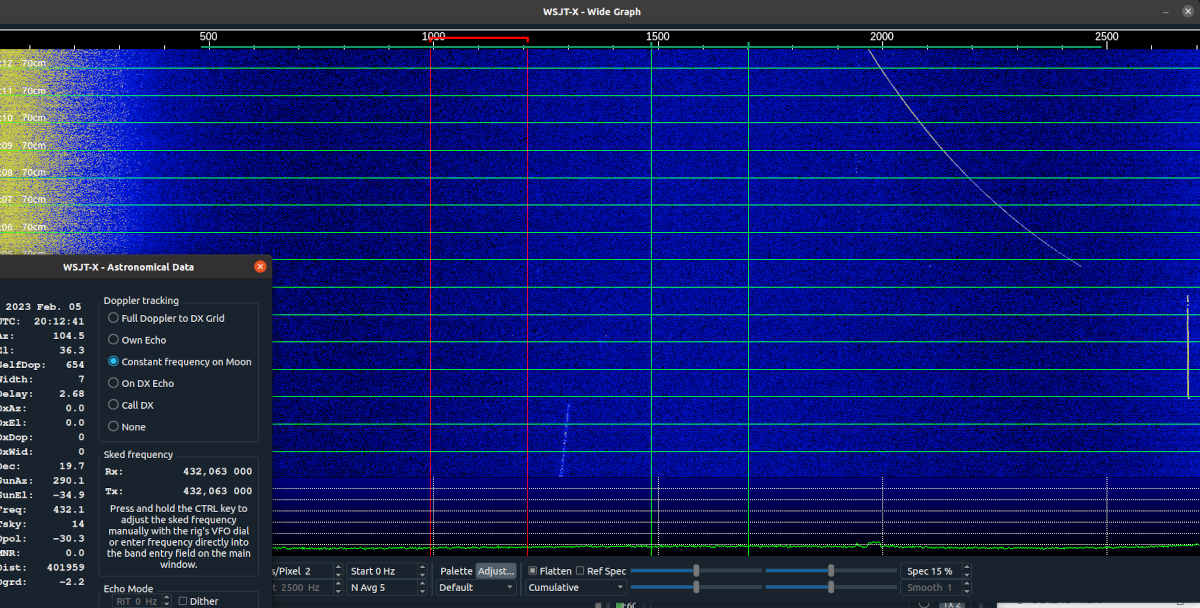
Bernd requested to TX in 2nd slot to see if the TX path was ok. Surprisingly he received my signal with -25 using Q65 mode (see following screenshot provided by DL7APV). I tried a few things including changing polarization from H to V and back again but I was not able to receive his (strong) signal this time.
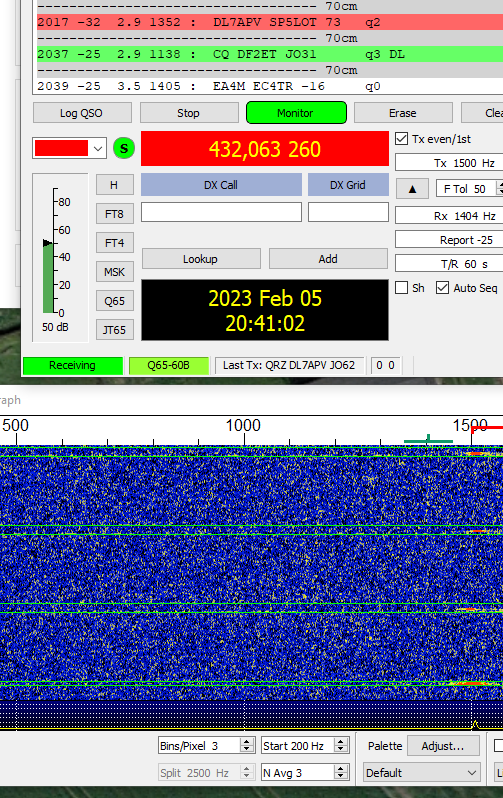
I followed the activities in HB9Q logger for some days and some time later tried again from home. This attempt also failed namley due to bad weather. I simply could not see the moon and point my antenna accordingly. Some experirments were made using a web based moon tracker (see [3]) but this was too inaccurate. So this was cancelled after an hour of fishing in the mud.
The third and finally succesful attempt was made some days later. The weather was good (dry and clear sky after sunset). Following the activity in HB9Q logger after SA5IKN’s announcement it seemed to be a good opportunity. Stuff was grabbed and loaded to the car. IC-9700 was pulled from the shack along with a 50Ah LiFePo4 battery and a notebook. This time I went a few kms away hoping for lower local interference and QRM.
The equipment was (as used in the previous two attempts):
- IC-9700
- 10el Yagi (Alaskan Arrow 10⁄4 with only 70cm elements mounted)
- 30cm semi rigid cable (RG-42) BNC-N
- Tripod
- 50 Ah LiFePo4 battery
- Notebook with WSJT-X improved plus v2.6.1
I went for a place a little more rural than at home. Moon was well above the horizon (app. 34° elevation) and about 387,000km in distanc (see [4]).
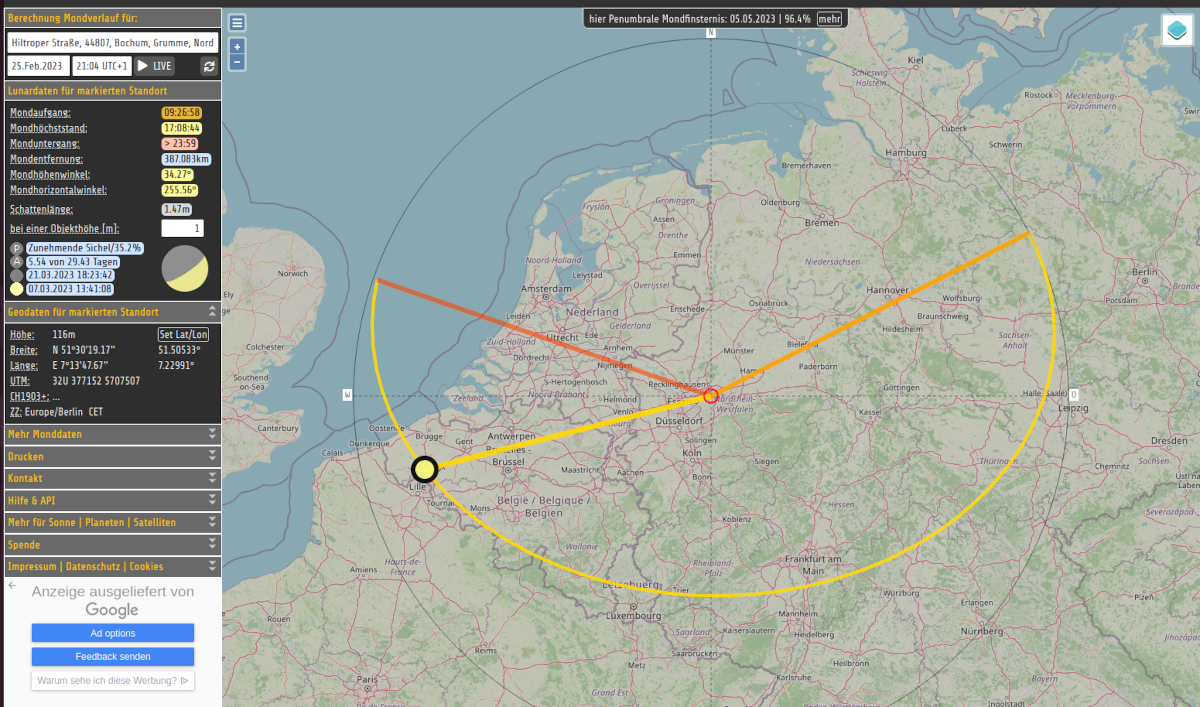
The station was setup with some storage boxes so that the TRX could be placed as near to the antenna as possible (sorry no time to construct a proper equipment mount).
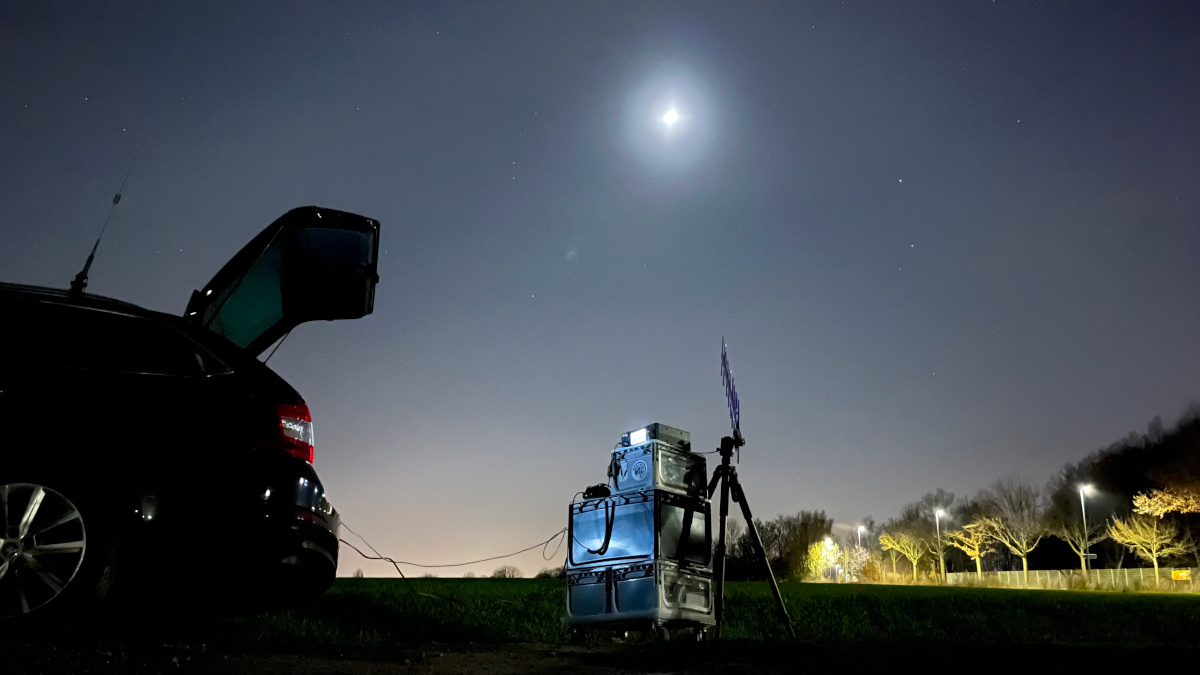
The first signal was received shortly after setup. It was PA0BAT in PA. This lead me to believe that my RX path was ok. After a short discussion in HB9Q logger I was elucidated that this must have been via tropo because the time difference dT (here -0.3) was way to low for being received via the moon.
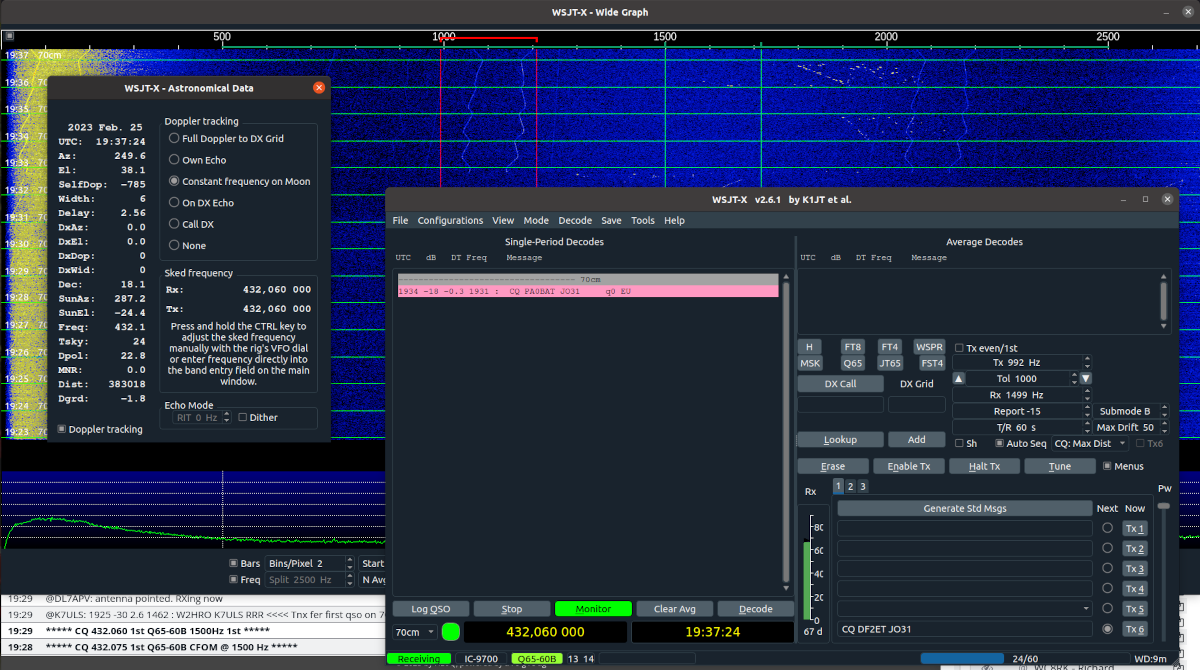
So I continued waiting for Bernd’s signal to appear. The waterfall showed some QRM which I believe was emitted by the notebook and/or the battery management system of my LiFePo4 battery. So notebook and battery were placed in the compartement of my car. But still the signal would not appear. Following a hint by Bernd I switch polarization from H to V and a few minutes later: Bang! The EME beacon appeared on my waterfal. The signal was clearly visible and at times even audible in the headphones. Right after Bernd’s first CQ call I answered and we made the QSO even with a nice message exchange at the end of the QSO.
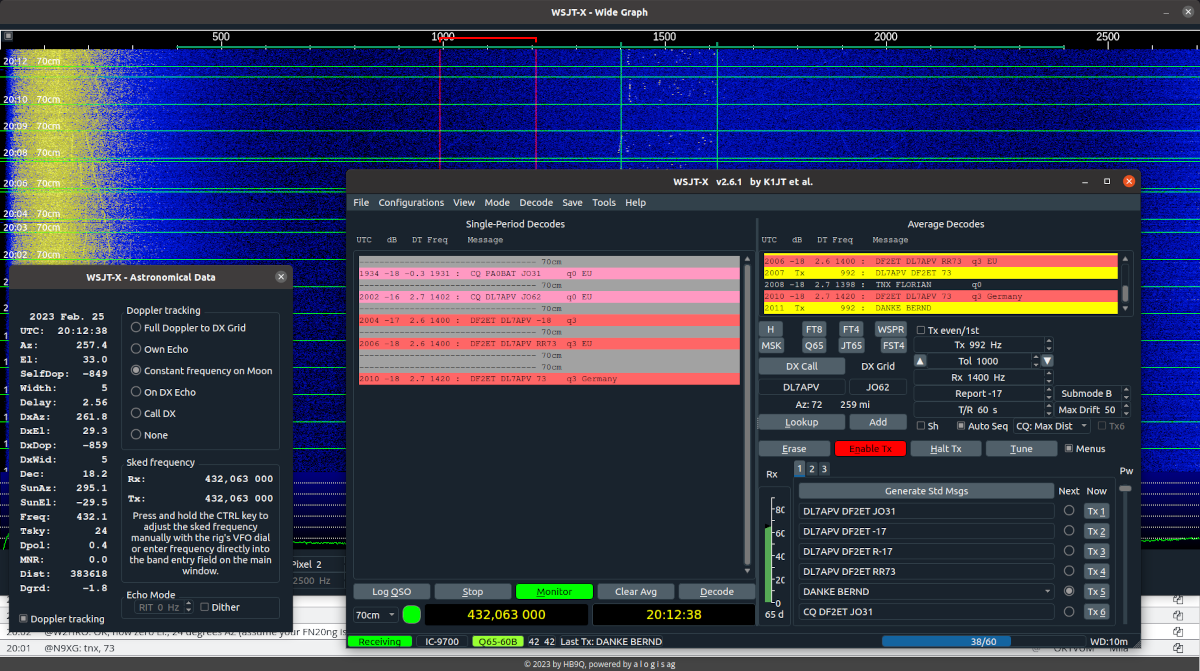
This was a great experience after hours of trying. Following the HB9Q logger I tried to receive some of the other stations that were active at that time but all of them were obviously not as capable as DL7APV. So I called it a day and disassembled my station.
For the ones trying to do alike a few hints and some information:
I used my IC-9700 barefoot with full power on TX which is 75W on 70cm. No (external) preamplifier was used. Internal preamp of the IC-9700 was active. NB and NR were disabled. A 2.7kHz filter and USB-D mode was used. The IC-9700 was used without (external) reference frequency. In fact the Leo Bodnar board is ordered but did not arrive yet.
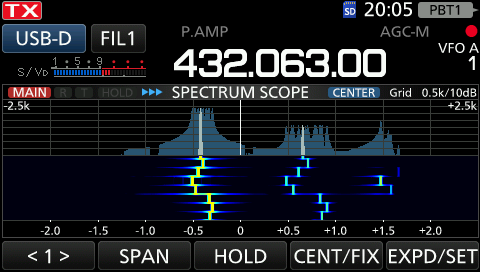
WSJT-X improved was used with settings from standard FT8 QSOs on HF and QO-100 satellite meaning rig control enabled, PTT via CAT command, rig in PKT mode. For EME the VHF features were enabled in the config as well as the decoding after EME delay. There is a nice guide by SA5IKN on [5]. Mode was set to Q65 submode B, tolerance to 1000, mas drift to 50 and T/R period to 60s. Besides that constant frequency on moon (CFOM) was enabled from the astronomical data view. All mode settings can be seen in my first screenshot above (RX of PA0BAT).
Next up for me is to hunt a few more of the big guns on EME with my /p setup. Maybe UA3PTW ([6]), HB9Q, DG5CST and more. And after all there is at lease some more theory to read by SA5IKN (see [7]). And there is also some more very valuable sources of information which I only discovered after my QSO with DL7APV: The hints by Bernd (for small EME stations) on [8] and a nice spotting tool available on [9].
Update
Bernd was so nice as to provide me with some screenshots of our QSO from his side. Of course he has worked some more stations than I ever heard :). And please remember if you see your callsign on these screenshots you have been heard by DL7APV and not me ;-).
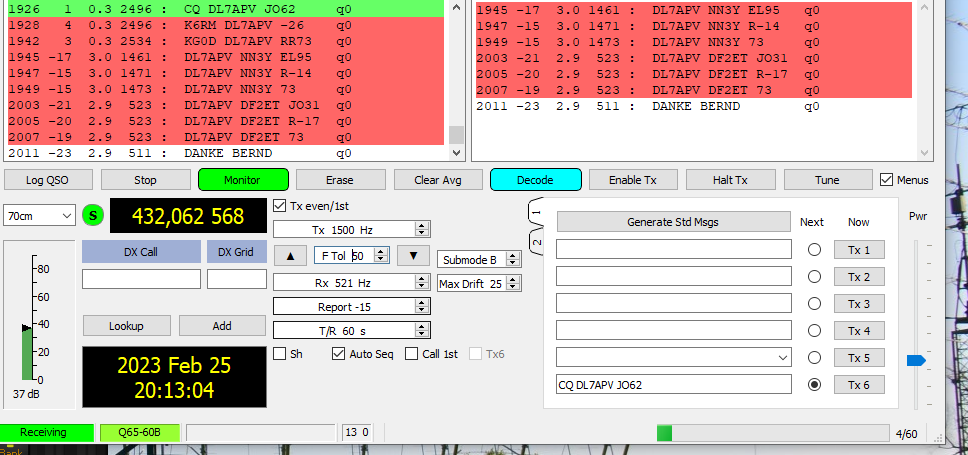
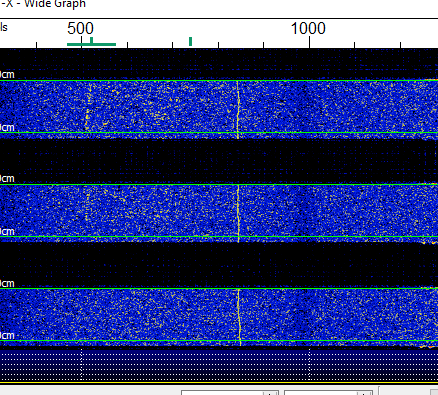
Bernd was so kind as to confirm our 70cm EME QSO on LotW. Based on his locator (JO62) the direct distance between our stations was roughly 406km where the signal path via the moon was roughly 774,167 km resulting in a signal transit time of roughly 2.5 sec.
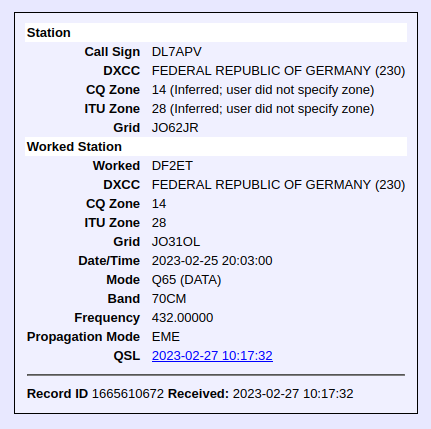
References
[1] https://twitter.com/M0SKN_SA5IKN/status/1620467867287449601
[2] https://logger.hb9q.ch/
[3] https://www.mondverlauf.de/
[4] https://www.mondverlauf.de/#/51.5053,7.2299,7⁄2023.02.25⁄21:04/1/0
[5] https://twitter.com/M0SKN_SA5IKN/status/1620467867287449601
[6] https://twitter.com/M0SKN_SA5IKN/status/1619779711118491648
[7] https://twitter.com/M0SKN_SA5IKN/status/1629474932609392642
[8] http://www.dl7apv.de/hints/hints.htm
[9] https://www.livecq.eu/432/